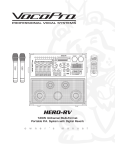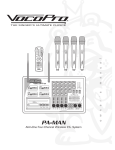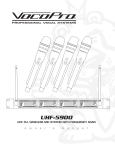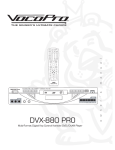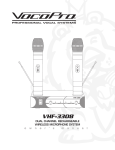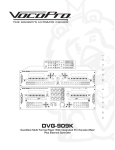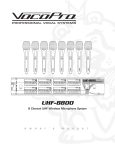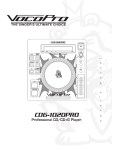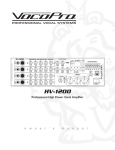Download VocoPro UHF-8900 Operating instructions
Transcript
UHF-8900 UHF PLL WIRELESS MIC SYSTEM WITH FREQUENCY SCAN o w n e r ' s m a n u a l Table of Contents Safety Instructions . . . . . . . . FCC Information . . . . . . . . . . Welcome . . . . . . . . . . . . . . Listening for a Lifetime . . . . . Features . . . . . . . . . . . . . . Getting Connected . . . . . . . . Descriptions and Functions . . Setting up the Microphones . Re-syncing the Microphones . Using the Wireless Mics . . . . Basic Operations . . . . . . . . . Advanced Operations . . . . . . Frequency Reference . . . . . . Troubleshooting . . . . . . . . . . . . . . . . . . . . . . . . . . . . . . . . . . . . . . . . . . . . . . . . . . . . . . . . . . . . . . . . . . . . . . . . . . . . . . . . . . . . . . . . . . . . . . 3 . 4 . 5 . 6 . 7 . 8 10 13 16 17 18 19 20 23 Safety Instructions 8. Ventilation - The appliance should be situated so its location does not interfere with its proper ventilation. For example, the appliance should not be situated on a bed, sofa, rug, or similar surface that may block the ventilation slots. CAUTION RISK OF SHOCK CAUTION: To reduce the risk of electric shock, do not remove cover (or back). No user-serviceable parts inside. Only refer servicing to qualified service personnel. 9. Heat - The appliance should be situated away from heat sources such as radiators, heat registers, stoves, or other appliances (including amplifiers) that produce heat. 10. Power Sources - The appliance should be connected to a power supply only of the type described in the operating instructions or as marked on the appliance. Explanation of Graphical Symbols The lightning flash & arrowhead symbol, within an equilateral triangle, is intended to alert you to the presence of danger. 11. Grounding or Polarization - Precautions should be taken so that the grounding or polarization means of an appliance is not defeated. 12. Power-Cord Protection - Power-supply cords should be routed so that they are not likely to be walked on or pinched by items placed upon or against them, paying particular attention to cords at plugs, convenience receptacles, and the point where they exit from the appliance. The exclamation point within an equilateral triangle is intended to alert you to the presence of important operating and servicing instructions. WARNING 13. Cleaning - Unplug this unit from the wall outlet before cleaning. Do not use liquid cleaners or aerosol cleaners. Use a damp cloth for cleaning. To reduce the risk of fire or electric shock, do not expose this unit to rain or moisture. 14. Power lines - An outdoor antenna should be located away from power lines. 1. Read Instructions - All the safety and operating instructions should be read before the appliance is operated. 15. Nonuse Periods - The power cord of the appliance should be unplugged from the outlet when left unused for a long period of time. 2. Retain Instructions - The safety and operating instructions should be retained for future reference. 16. Object and Liquid Entry - Care should be taken so that objects do not fall and liquids are not spilled into the enclosure through openings. 3. Heed Warnings - All warnings on the appliance and in the operating instructions should be adhered to. 17. Damage Requiring Service - The appliance should be serviced by qualified service personnel when: 4. Follow Instructions - All operating and use instructions should be followed. A. B. C. D. The power supply cord or plug has been damaged; or Objects have fallen into the appliance; or The appliance has been exposed to rain; or The appliance does not appear to operate normally or exhibits a marked change in performance; or E. The appliance has been dropped, or the enclosure damaged. 5. Attachments - Do not use attachments not recommended by the product manufacturer as they may cause hazards. 6. Water and Moisture - Do not use this unit near water. For example, near a bathtub or in a wet basement and the like. 18. Servicing - The user should not attempt to service the appliance beyond that described in the operating instructions. All other servicing should be referred to qualified service personnel. 7. Carts and Stands - The appliance should be used only with a cart or stand that is recommended by the manufacturer. Note: To CATV system installer's (U.S.A.): This reminder is provided to call the CATV system installer's attention to Article 820-40 of the NEC that provides guidelines for proper grounding and, in particular, specifies that the cable ground shall be connected as close to the point of cable entry as practical. 7 A. An appliance and cart combination should be moved with care. Quick stops, excessive force, and uneven surfaces may cause an overturn. 3 FCC Information 1. IMPORTANT NOTICE: DO NOT MODIFY THIS UNIT!: This product, when installed as indicated in the instructions contained in this manual, meets FCC requirements. Modifications not expressly approved by Vocopro may void your authority, granted by the FCC, to use this product. 2. IMPORTANT: When connecting this product to accessories and/or another product use only high quality shielded cables. Cable(s) supplied with this product MUST be used. Follow all installation instructions. Failure to follow instructions could void your FCC authorization to use this product in the U.S.A. 3. NOTE: This product has been tested and found to comply with the requirements listed in FCC Regulations, Part 15 for Class "B" digital devices. Compliance with these requirements provides a reasonable level of assurances that your use of this product in a residential environment will not result in harmful interference with other electronic devices. This equipment generates/uses radio frequencies and, if not installed and used according to the instructions found in the owner's manual, may cause interference harmful to the operation of other electronic devices. Compliance with FCC regulations does not guarantee that interference will not occur in all installations. If this product is found to be the source of interference, which can be determined by turning the unit "Off" and "On", please try to eliminate the problem by using one of the following measures: Relocate either this product or the device that is being affected by the interference. Use power outlets that are on different branch (circuit breaker or fuse) circuits or install AC line filter(s). In the case of radio or TV interference, relocate/reorient the antenna. If the antenna lead-in is 300-ohm ribbon lead, change the lead-in to coaxial type cable. If these corrective measures do not produce satisfactory results, please contact your local retailer authorized to distribute Vocopro products. If you can not locate the appropriate retailer, please contact Vocopro, 1728 Curtiss Court, La Verne, CA 91750. CAUTION The apparatus is not disconnected from the AC power source so long as it is connected to the wall outlet, even if the apparatus itself is turned off. To fully ensure that the apparatus is indeed fully void of residual power, leave unit disconnected from the AC outlet for at least fifteen seconds. CAUTION: READ THIS BEFORE OPERATING YOUR UNIT 1. To ensure the finest performance, please read this manual carefully. Keep it in a safe place for future reference. 2. Install your unit in a cool, dry, clean place - away from windows, heat sources, and too much vibration, dust, moisture or cold. Avoid sources of hum (transformers, motors). To prevent fire or electrical shock, do not expose to rain and water. 3. Do not operate the unit upside-down. 4. Never open the cabinet. If a foreign object drops into the set, contact your dealer. 5. Place the unit in a location with adequate air circulation. Do not interfere with its proper ventilation; this will cause the internal temperature to rise and may result in a failure. 6. Do not use force on switches, knobs or cords. When moving the unit, first turn the unit off. Then gently disconnect the power plug and the cords connecting to other equipment. Never pull the cord itself. 7. Do not attempt to clean the unit with chemical solvents: this might damage the finish. Use a clean, dry cloth. 8. Be sure to read the "Troubleshooting" section on common operating errors before concluding that your unit is faulty. 9. This unit consumes a fair amount of power even when the power switch is turned off. We recommend that you unplug the power cord from the wall outlet if the unit is not going to be used for a long time. This will save electricity and help prevent fire hazards. To disconnect the cord, pull it out by grasping the plug. Never pull the cord itself. 10. To prevent lightning damage, pull out the power cord and remove the antenna cable during an electrical storm. 11. The general digital signals may interfere with other equipment such as tuners or receivers. Move the system farther away from such equipment if interference is observed. NOTE: Please check the copyright laws in your country before recording from records, compact discs, radio, etc. Recording of copyrighted material may infringe copyright laws. Voltage Selector (General Model Only) Be sure to position the voltage selector to match the voltage of your local power lines before installing the unit. 110V 4 Welcome And thank you for purchasing the UHF-8900 from VocoPro, your ultimate choice in vocal entertainment! With years of experience in the music entertainment business, VocoPro is a leading manufacturer of vocal equipment, and has been providing patrons of bars, churches, schools, clubs and individual consumers the opportunity to sound like a star with full-scale club models, in-home systems and mobile units. All our products offer solid performance and sound reliability, and to reinforce our commitment to customer satisfaction, we have customer service and technical support professionals ready to assist you with your needs. We have provided some contact information for you below. VocoPro 1728 Curtiss Court La Verne, CA 91750 Toll Free: 800-678-5348 TEL: 909-593-8893 FAX: 909-593-8890 VocoPro Company Email Directory Customer Service & General Information [email protected] Tech Support [email protected] Remember Our Website Be sure to visit the VocoPro website www.vocopro.com for the latest information on new products, packages and promos. And while you're there don't forget to check out our Club VocoPro for Karaoke news and events, chat rooms, club directories and even a KJ Service directory! We look forward to hearing you sound like a PRO, with VocoPro, the singer’s ultimate choice. FOR YOUR RECORDS Please record the model number and serial number below, for easy reference, in case of loss or theft. These numbers are located on the rear panel of the unit. Space is also provided for other relevant information Model Number Serial Number Date of Purchase Place of Purchase 5 Listening for a Lifetime Selecting fine audio equipment such as the unit youʼve just purchased is only the start of your musical enjoyment. Now itʼs time to consider how you can maximize the fun and excitement your equipment offers. VocoPro and the Electronic Industries Associationʼs Consumer Electronics Group want you to get the most out of your equipment by playing it at a safe level. One that lets the sound come through loud and clear without annoying blaring or distortion and, most importantly, without affecting your sensitive hearing. Sound can be deceiving. Over time your hearing “comfort level” adapts to a higher volume of sound. So what sounds “normal” can actually be loud and harmful to your hearing. Guard against this by setting your equipment at a safe level BEFORE your hearing adapts. To establish a safe level: • Start your volume control at a low setting. • Slowly increase the sound until you can hear it comfortably and clearly, and without distortion. Once you have established a comfortable sound level: • Set the dial and leave it there. • Pay attention to the different levels in various recordings. Taking a minute to do this now will help to prevent hearing damage or loss in the future. After all, we want you listening for a lifetime. Used wisely, your new sound equipment will provide a lifetime of fun and enjoyment. Since hearing damage from loud noise is often undetectable until it is too late, this manufacturer and the Electronic Industries Associationʼs Consumer Electronics Group recommend you avoid prolonged exposure to excessive noise. This list of sound levels is included for your protection. Some common decibel ranges: Level 30 40 50 60 70 80 Example Quiet library, Soft whispers Living room, Refrigerator, Bedroom away from traffic Light traffic, Normal Conversation Air Conditioner at 20 ft., Sewing machine Vacuum cleaner, Hair dryer, Noisy Restaurant Average city traffic, Garbage disposals, Alarm clock at 2 ft. The following noises can be dangerous under constant exposure: Level 90 100 120 140 180 Example Subway, Motorcycle, Truck traffic, Lawn Mower Garbage truck, Chainsaw, Pneumatics drill Rock band concert in front of speakers Gunshot blast, Jet plane Rocket launching pad -Information courtesy of the Deafness Research Foundation 6 Features Features • • • • • • 8 UHF PLL wireless microphones Frequency scan feature finds interference-free channels More than 150 wireless frequencies available LCD display shows frequency and other info 19” rack mountable chassis, uses just 2 rack spaces Independent power knob and volume control per channel • 8 balanced XLR outputs • (2) ¼” unblanced mixed outputs • Includes (2) ¼” unbalanced microphone cables and metal carrying case (2) 7 Getting Connected Connecting Power 1. Ensure the main power switch on the rear panel is set to OFF. 2. Connect the power adapter to the power input on the rear panel. 3. Plug the power adapter into a power outlet, or a surge protector. Note: A surge protector is recommended to protect your equipment from power surges. Connecting Audio Using the XLR outputs The XLR outputs allow you to connect each channel to the mixer independently. This gives you more control over the individual microphone channels when connected to a mixer. You will need: • UHF-8900 • 8 XLR patch cables (not included) • An input device, such as a mixer or amplifier (not included) To Connect the XLR outputs: 1. Ensure the main power switch on the rear panel is turned off. 2. Connect one end of an XLR cable to the CH.1 output of the UHF-8900. 3. Connect the other end of the XLR cable to the desired input on your mixer. 4 3 2 1 UHF-8900 rear panel 4 3 2 1 Mixer Note: To avoid confusion, it’s recommended that the XLR jacks are attached correspondingly (e.g. CH.1 to CH. 1, CH. 2 to CH. 2, etc. The illustrated setup is for clarity only.) 4. Repeat steps 2 and 3 until all the XLR outputs are connected. Using the ¼” mixed output The ¼” mixed output is useful if you do not have a mixer or if you have limited inputs available on your mixer. All 4 microphone signals are mixed together in this output. You will need: • UHF-8900 • (2) ¼” patch cables (included) • An input device, such as a mixer or amplifier (not included) UHF-8900 rear panel To Connect the ¼” output: 1. Ensure the main power switch on the rear panel is turned off. 2. Connect one end of a ¼” cable to one of the ¼” mixed output on the rear panel of the UHF-8900. 3. Connect the other end of the ¼” cable to the desired input on your mixer or amplifier. 4. Repeat steps 2 and 3 for the second ¼” mixed output jack. 8 Mixer Getting Connected Connecting Antennas The Antennas receive the UHF wireless signals from the microphones. 1. Attach the antennas to the connectors on the front panel by twisting them clockwise until firmly attached. 2. To disconnect the antennas, twist counter-clockwise. Note: Please be sure to attach the 900MHz antennas to the top 2 antenna posts and attach the 600MHz antennas to the bottom 2 posts. Attaching the Rack Brackets The UHF-8900 comes with detachable rack brackets which allows the unit to be installed in a standard 19 inch rack. 1. Use the included screws to fasten the rack brackets to the sides of the UHF-8900 as shown in the illustration below. Mounting the UHF-8900 in a Rack The UHF-8900 will fit in a standard 19” rack (not included). 1. Align the UHF-8900 with the desired space in rack and slowly slide in, rear panel first. Note: Depending on your rack case design, it may be necessary to allow for sufficient space for the antennas. 2. While aligned, use rack case screws (not included) in the order shown below to stabilize the UHF-8900 in its space, using the “X” rotation (numbered below) will ensure even tension and flush alignment. Note: Do not tighten screws firmly until all screws are in place. 1 2 3 4 9 Descriptions and Functions 1 3 2 4 8 5 7 6 Front Panel 1. Antenna Connector - Connect the antennas to these connectors to receive the wireless signals from the microphones. 2. Main Power Switch - This switch turns the power on and off for the whole unit. 3. Power/Volume Knob - Turn clockwise, until it clicks, to toggle OFF/ON. - Turn clockwise past the click, to turn up the microphone volume for that channel.. 4. Module Display Window - This LCD screen displays information about this module. See the Module Display Window descriptions and functions for more details. 5. Up/Set Button - Used to scroll up menu selections. When in IR Mode, it is used to confirm the desired frequency when choosing manually. 6. Menu Button - Used to cycle through menu screens. Press once (1x) to toggle into the Group (GR) Selection menu. Press twice (2x) to toggle into the Automatic Scan. Press three times (3x) to toggle into the Channel (CH) Selection menu. Press four times (4x) to toggle into IR Mode. Note: Module menus have a 4 second timeout period. If the menu button wasn’t pressed within that time, the display will revert to the frequency information screen. 7. Down Button - Used to scroll down menu selections. 8. IR Sensor - Used to sync the desired microphone to the desired module. Note: IR communication range is approximately 7 inches. 10 Descriptions and Functions 1 2 3 4 5 6 7 Module Display Window 1. MUTE Indicator - Displays when corresponding mic is off or disconnected. The Mute Mode is an automatic function. 2. Group and Channel - Displays the group and channel that the module is set to. *See Displaying the Group & Frequency page for details. 3. IR (infrared) Mode Indicator - Indicates when the module is in IR Mode, which is used to assign a microphone to a module. 4. Squelch* - Displays the current Squelch level for this module. 5. SCAN Mode Indicator - Shows when this module is in SCAN mode, which is used to search for an interference free frequency. 6. Lock - Setting alterations are disabled for that module when displayed. Note: Press Menu+Set buttons simultaneously to toggle the Lock 6. AF/RF Level Bars - The RF bar displays signal strength of the synced microphone. The AF bar displays the strength of the audio signal being received from the microphone. 7. Channel Frequency - Displays what frequency this module is currently set to. 1 Rear Panel 1 2 3 1. Independent XLR Channel Outputs - These 8 balanced jacks output audio from each module independently. 2. Mixed Audio Output - These unbalanced jacks output the audio of all the modules in their respective rows. 3. Power Adapter Plug* - Attach the power adapter here to provide power to the receiver. * See commonly asked questions for definition 11 Descriptions and Functions Microphones 1. IR (infrared) Sensor - This sensor receives the infrared signal that is used to set the frequency that the wireless mic will use. This sensor is only used to set the microphone frequency, it does not send or receive audio signal. 2. Power LED - This LED indicator will turn green when the microphone is turned on. It will turn red when the batteries need to be replaced. 3. ON/OFF Switch - This switch turns the microphone on or off. Installing the Batteries To install the wireless mic batteries: 1. Remove the battery cover. 2. Insert two fresh AA batteries. Make sure they are facing the correct direction. 3. Replace the battery cover. 12 Setting up the Microphones Overview The goal is for each of the UHF-8900’s wireless channels to be operating on a frequency free of interference. This can be accomplished two ways 1) automatic frequency selection, and 2) manual frequency selection. We recommend using the automatic method first, as this method will work well for most areas. However, if you live in a metropolitan area where RF activity is dense, manual frequency selection may work better for you. If you choose the manual method, we recommend first obtaining information on your proximity to TV towers. Frequencies and Groups The UHF-8900 has a total of 177 available frequencies. These frequencies are broken down into groups. The two channels on the left are assigned GROUPS GR1-1 through GR1-C, while the two channels on the right are assigned GROUPS GR2-1 through GR2-C. The top Module row - The groups are listed sequentially starting from GR 01 through GR 05. The bottom Module row (Left 2 Modules) - The Groups are listed as GR 1-1 through G 1-A. The bottom Module row (Right 2 Modules) - The Groups are listed as GR 2-1 through GR 2-A. Pressing Buttons: 4 Second Default When cycling through the selection modes and parameters using the MENU, UP, & DOWN buttons, if a selection is not made within 4 seconds, the system will automatically revert to the Frequency Information Screen. So, let’s say you are trying to change to a channel in a different group. After pressing MENU, you have only 5 seconds to press the UP/DOWN arrows to browse through the available groups. This applies to every step of the frequency setup procedure, so keep this in mind. If this happens, simply wait for it to finish and resume where you left off. Other Devices 90° Be sure to power on any other devices that may potentially interfere with the UHF-8900 (other wireless systems) BEFORE you begin the frequency selection process. This way, you will not have any surprises when they are powered on. Antenna Positioning For the best reception, position the receiver antennas at 90 degrees from each other. (see illustration). WARNING: Please be sure to attach the 900MHz antennas to the top 2 antenna posts and attach the 600MHz antennas to the bottom 2 posts. 13 Setting up the Microphones Setting the Frequencies Automatically The microphones will be ready to use right out of the box. The below instructions are intended if interference is experienced at the venue being performed at. The Automatic instructions should be tried first and if problems persist, try the Manual settings. Note: Please read through the steps before attempting to sync the microphones. The module menus have a 4 second timeout period where if a button is not pressed within that time the module will revert back to the frequency information screen. wireless microphone AUTOMATIC SETUP Setting up the microphones using the frequency scan function. 1. Prepare the System: Ensure the receiver base, the desired module to be paired, and the desired microphone to be paired, are all powered on. 2. Identify the IR Sensors: Locate the IR Sensor on both microphone and module. A.) Microphone - The IR Sensor is located just above the ON/OFF switch. B.) Module - The IR Sensor is located directly below the module volume knob. 3 UP VOL SET SCAN 3. Align the IR Sensors: Position the microphone so that the 2 IR sensors are level and within 3-5 inches of one another. 4. Select Scan: Press the MENU button on the desired module twice (2x). This will display the symbol “Scan” on the LCD. The Scan Mode will last approximately 4 seconds. 5. Sync the Mic: The “Scan” symbol will be replaced with the “IR” symbol. With the IR symbol displayed, press the SET button to communicate the desired frequency to the microphone. This will display waves emanating from the “IR” symbol, when the waves disappear the screen will display the chosen frequency, as well as the AF and RF reception bars for that channel. 6. Test the Mic: Speak into the microphone to ensure sound in being produced and transmitted. The AF bars on the LCD should register as the microphone is spoken into. IR 4 PLL WIRELESS SYSTEM WITH FREQUENCY SCAN UHF-8900 UHF VOL 5 IR PROGRAM MODE IR SET MENU PLL WIRELESS SYSTEM WITH FREQUENCY SCAN UHF-8900 UHF VOL SET MENU 6 IR 14 MENU SCAN Note: Once the microphone and module are synced, there will be a 5 second delay in audio each time the microphone is powered on. This is normal. 7. Repeat the Process: Repeat steps 3-6 for each of the remaining microphones and modules. DOWN PLL WIRELESS SYSTEM WITH FREQUENCY SCAN UHF-8900 UHF Setting up the Microphones Setting the Frequencies Manually If the UHF-8900 is used in an area with heavy RF interference, it may be beneficial to set the frequencies manually. Please refer to the Advance Operation page to determine which frequencies to use for that area. Note: Please read through the steps before attempting to sync the microphones. The module menus have a 4 second timeout period where if a button is not pressed within that time the module will revert back to the frequency information page. wireless microphone MANUAL SETUP Setting up the frequencies manually 1. Prepare the System: Ensure the receiver base, the desired module to be paired, and the desired microphone to be paired, are all powered on. 2. Identify the IR Sensors: Locate the IR sensor on both the microphone and module. A.) Microphone - The IR sensor is located just above the ON/OFF switch. B.) Module - The IR sensor is located directly below the module volume knob. 3. Align the IR Sensors: Position the microphone so that the 2 IR sensors are level and within 3-5 inches of one another. 4. Select a Group (GR): Press the Menu button on the desired module once (1x). This will display the symbol “GR” on the LCD. With the “GR” symbol displayed, use the UP/DOWN buttons to select the desired group. 5. Select a Channel (CH): Press the MENU button on the desired module twice (2x). This will cycle the menu past the “SCAN” screen and enter the Channel (CH) selection screen; this will display the symbol “CH” on the LCD. With the CH symbol displayed, use the UP/DOWN buttons to select the desired channel. 6. Sync Microphone: Press the MENU button once (1x) to enter IR mode; this will display the symbol “IR” on the LCD. With the IR symbol displayed, press the SET button to communicate the desired frequency to the microphone. This will display waves emanating from the “IR” symbol, when the waves disappear the screen will display the chosen frequency, as well as the AF and RF reception bars for that channel. 3 VOL GROUP SYMBOL SET DOWN IR MENU 4 PLL WIRELESS SYSTEM WITH FREQUENCY SCAN UHF-8900 UHF VOL CHANNEL SYMBOL UP SET MENU 5 IR DOWN PLL WIRELESS SYSTEM WITH FREQUENCY SCAN UHF-8900 UHF VOL IR PROGRAM MODE IR SET SET MENU 6 PLL WIRELESS SYSTEM WITH FREQUENCY SCAN UHF-8900 UHF 7. Test the Mic: Speak into the microphone to ensure sound is being produced and transmitted. The AF bars on the LCD should register as the microphone is spoken into. Note: Once the microphone and module are synced, there will be a 5 second delay in audio when the microphone is powered on. This is normal. UP VOL SET MENU 7 8. Repeat the Process: Repeat steps 3-7 for each of the remaining microphone and modules. IR 15 PLL WIRELESS SYSTEM WITH FREQUENCY SCAN UHF-8900 UHF Re-syncing the Wireless Mics Occasionally the microphone will need to be re-synced with the respective module. The frequency is the same but the connection between mic and module is lost. Note: Please read through the steps before attempting to sync the microphones. The module menus have a 4 second timeout period where if a button is not pressed within that time the module will revert back to the frequency information page. 1. Prepare the system: Ensure the receiver base, the desired module to be paired, and the desired microphone to be paired, are all powered on. wireless microphone 2. Identify the IR Sensors: Locate the IR Sensor on both microphone and module. A.) Microphone - The IR Sensor is located just above the ON/OFF switch. B.) Module - The IR Sensor is located directly below the module volume knob. 3. Align the IR Sensors: Position the microphone so that the 2 IR Sensors are level within 3-5 inches of one another. 4. Re-sync Microphone: Press the MENU button on the desired module for time (4x) to cycle the menu to IR mode; this will display the IR symbol. With the IR symbol displayed, press the SET button to communicate the existing frequency to the microphone. This will display waves emanating from the IR symbol, when the waves disappear, the screen will display the existing frequency, as well as the AF and RF reception bars for that channel. 3 UP VOL SET DOWN IR UHF-8900 VOL 16 4 SCAN 5. Test the Mic: Speak into the microphone to ensure sound is being produced and transmitted. The AF bars on the LCD should register as the microphone is spoken into. Note: Once the microphone and module are synced, there will be a 5 second delay in audio when the microphone is powered on. This is normal. MENU IR MODE UHF PLL WIRELESS SYSTEM WITH FREQUENCY SCAN SET MENU 5 IR PLL WIRELESS SYSTEM WITH FREQUENCY SCAN UHF-8900 UHF Using the Wireless Mics Microphone Position The UHF-8900 is ideal for close-up vocals and can be held in the hand or mounted on a mic stand. Keep in mind that microphone technique is largely a matter of personal taste, and there is no one “correct” microphone position. Feedback Feedback occurs when the amplified sound from any loudspeaker reenters the sound system through any open microphone and is repeatedly amplified. Most commonly, feedback is caused by the following conditions: • Placing loudspeakers too close to microphones. • Having too many open active microphones. • Boosting tone controls indiscriminately (mainly treble). • Performing in areas with high ratios of room surfaces that have hard and reflective surfaces such as glass, marble and wood. What to do if feedback occurs before the sound system is loud enough: • Request that the talker speak louder into the microphone. • Reduce the distance from the talker to the microphone. Each time this distance is halved, the sound system output will increase by 6dB. • Reduce the number of open microphones. • Move the loudspeaker farther away from the microphone. Each time this distance is doubled, the sound system output can be increased by 6dB. • Move the loudspeaker closer to the listener. • Use an equalizer/feedback reducer to cut the frequency bands in which the feedback occurs. Microphone Placement & Tone Quality Lead & Backup Vocals Lips should be less than 3” from or even touching the windscreen on an axis to the microphone. Doing this creates a robust sound, emphasizes bass and provides maximum isolation from other sources. Speech When giving a speech or simply speaking, place the microphone 4” to 10” away from the mouth, just above nose height for a natural sound with reduced bass. You can also place the microphone 8” to 16” away from the mouth, slightly off to one side, for a more “distant” sound with highly reduced bass and minimal “s” sounds. Using the Squelch control The Squelch control is used to mute unwanted noise interference from a microphone channel when the associated transmitter is turned off. Each channel has its own squelch control and should be set independently as necessary. Squelch can be set from 0 to 15, with 10-15 being represented by A-F. To adjust squelch: • For each channel, start with the squelch control set at ‘0’. If not at ‘0’, press and hold the DOWN ARROW until the display reads ‘SQ 0’. • Press and hold the UP ARROW to increase the squelch • Press and hold the DOWN ARROW to decrease the squelch. • You may need to turn the mic on/off to test if the squelch is at a sufficient level. NOTE: The higher the squelch is set for a particular channel, the shorter the range will be for that mic. At the maximum SQ level, the operational range is approximately 40ft. 17 Basic Operations Setting Up with Stage Monitors/P.A. System If you will be using the UHF-8900 with stage monitors and/or a P.A. system, try the following: • Place the stage monitor directly in front of the microphone. • Locate the P.A. loudspeakers so that they point away from the rear of the microphone. (With the speakers located in these positions, the possibility of feedback is greatly reduced). • Always check the stage setup before a performance to ensure optimum placement of microphone and monitors. PA Speakers Facing Away From Rear of Microphone Monitor Directly in Front of Microphone NOTE: Every wireless microphone installation is a unique situation, and can present a variety of problems. Never attempt a live performance without first conducting a “walkthrough” test of the system in the performing area. If major changes (additional wireless systems or intercoms, relocation of scenery, etc.) have been made since the last walk-through test, check the wireless system again, as close to performance time as possible. Avoiding Interference As with all RF devices, interference can be a problem. While some causes of interference are unavoidable, others can be avoided by taking certain precautions. Below are some helpful hints to avoid unwanted interference. • Make sure that the operating frequencies used with you wireless system do not coincide with local TV station broadcast frequencies. • If using multiple systems, or within range of other systems, check all wireless frequencies in use to make sure that no two frequencies are being used at the same time. • For all operating frequencies, make sure there is at least 1 MHz between each frequency. • Before using a system in a new location or another city, perform a walk-though to check for new problems. • Check the squelch control setting on the receiver. A higher squelch setting provides better protection against interference. However, since a high setting also can cause a reduction in operating range, set the control to the lowest position that reliably mutes the interference. • Make certain that all batteries are fresh and new. Weak batteries make a system more susceptible to interference. • If not in use, power down electronic equipment such as computers, CD players, and other digital devices, as they are a common source of wireless interference; especially if they are in close proximity to the receiver. • As much as feasible, keep computers and other digital devices at least 3 feet away from the wireless receiver and/ or its antennas. Improving Range To get the most usable range out of your wireless microphone system, follow the helpful hints below. • Always try to keep an unobstructed line of site between the wireless receiver’s antennas and the wireless transmitters. Metal objects between the wireless transmitters and receiver commonly reduce the operating range. • When mounting the wireless receiver, avoid mounting it behind other electronic equipment, low to the ground, or in remote equipment/sound rooms. • As far as feasible, minimize the amount of squelch applied to channels; the higher the squelch setting, the lesser the operating range. • When operating the wireless system, keep all wireless transmitters at least 10 feet away from the receiver and its antennas. Wireless transmitters in close proximity can overload the receiver and reduce its overall sensitivity, as well as possibly cause interference with other channels on the system. • Use only high-quality alkaline batteries in the wireless transmitters. Other types of batteries might not provide sufficient voltage and capacity for full power transmission. • Position the receiver antennas so they do not touch each other. 18 Advanced Operation Testing a Channel for Outside Interference Once a microphone and module have been successfully paired, turn the microphone OFF (leave the module ON). With the microphone off, if the RF indicator still has bars showing, there exists interference. Note that RF interference can ebb and flow. Sometimes it may appear as 4 steady bars on the RF indicator, other times, it may weakly occupy a single bar or two. Generally, we recommend looking for another channel if ANY bars register. Using the Frequency Scan In some areas the scan feature may not select an interference-free channel. This is not because the system is malfunctioning, but rather there are no interference-free channels available to choose from in that subgroup. If setting up in this kind, and do not want to use manual frequency selection, we recommend you do the following: 1. Start a Scan (see Setting the Frequencies Automatically for instructions) on the left module (1) using the first group. If there is no open channel in that group, repeat the Scan in the next group. Continue this process until an open channel is selected. (see above for how to test a channel for interference) 2. Begin the Scan process on the second module, but this time start with next available subgroup. 3. Repeat this process with the rest of the modules. Obtaining Local TV Tower Information The most common source of RF interference to the UHF-8900 is TV broadcast towers. If the UHF-8900 is experiencing dropouts, static, or other strange noises, it is likely RF interference at fault if within the threshold distance of 30 miles. Follow the instructions below to obtain the information on your proximity to broadcasting TV towers. (Applicable to the United States only) 1. 2. 3. 4. Visit www.antennaweb.org (see note below) Select “Click Here to Start” Enter the Zip Code in which the UHF-8900 will be used and hit Submit. The search results page that comes up will contain all the TV broadcasting stations within a 50 mile range. A.) The information provided for each channel is: I. Station Name II. RF Channel - This is the information to be interested in III. Distance and Heading 5. Write down all of the RF Channel numbers for each of the search results. Note: Only TV stations within 30 miles would cause issues with the microphones. 6. Refer to the TV Channel Frequency List (page 20) to determine which frequencies not to use. 7. Use the UHF-8900 Frequency List to determine which group and channels that are NOT being interfered with. Please Note: antennaweb.org is a third party website and is not maintained by nor affiliated with Vocopro. For example, let’s say you did a search in your area (this example shows zip code 05456) and received the following information: The only relevant channel is 43, therefore you would jot it down to cross-reference with TV frequency list (page 20) After cross-referencing, you find that channel 43 uses the frequency range of 644 to 650 MHz. You would NOT choose a frequency that falls in that range. 19 Displaying the Group & Frequency The module LCD displays all the information regarding the microphone Group (GR) and Channel (CH). It is important to understand what each icon represents. • Frequency: This is the frequency that the microphone is currently using. It is easier to refer to this as a combination of both Group and Channel numbers. For example: 655.MHz would be GR 2-1 & CH 01. • Group: The Group number is the subset of frequencies to choose from in each module. The UHF-8900 displays the module in a few different ways The top Module row - The groups are listed sequentially starting from GR 01 through GR 05. The bottom Module row (Left 2 Modules) - The Groups are listed as GR 1-1 through G 1-A The bottom Module row (Right 2 Modules) - The Groups are listed as GR 2-1 through GR 2-A. • Channel: This is the number of frequencies in each Group. These are listed the same way in all modules, CH 01 and up. Please refer to pg. for a complete list of Groups and Frequencies to choose from. UHF-8900 Frequency List Used by the top 4 modules GR 01 GR 02 GR 03 GR 04 GR 05 CH 01 902.60 906.00 903.75 902.70 905.00 CH 02 906.90 904.40 907.60 904.60 907.75 CH 03 908.05 914.90 909.40 908.20 909.20 CH 04 912.80 917.50 916.00 911.95 911.05 CH 05 914.25 919.10 919.50 914.90 916.15 CH 06 915.95 921.85 921.10 922.75 922.75 CH 07 917.25 924.80 923.55 925.40 923.85 CH 08 925.30 926.80 925.60 927.55 927.70 20 UHF-8900 Frequency List GR 1-1 GR 1-2 GR 1-3 GR 1-4 GR 05 GR 1-6 CH 01 614.000 615.000 616.300 614.000 620.000 626.000 CH 02 617.100 617.700 621.000 614.500 620.500 626.500 CH 03 621.200 623.300 627.000 625.200 621.200 627.200 CH 04 622.200 627.400 633.300 616.100 622.100 628.100 CH 05 627.100 633.900 639.000 617.500 623.500 629.500 CH 06 628.800 641.600 646.000 619.300 625.300 631.300 CH 07 632.100 648.600 652.600 CH 08 634.400 650.300 CH 09 638.400 CH 10 642.200 CH 11 644.200 CH 12 644.800 CH 13 651.900 GR 1-7 GR 1-8 GR 1-9 GR 1-A CH 01 632.000 638.000 644.000 650.000 CH 02 632.500 638.500 644.500 650.500 CH 03 633.200 639.200 645.200 651.200 CH 04 634.100 640.100 646.100 652.100 CH 05 635.500 641.500 647.500 653.500 CH 06 637.300 643.300 649.300 GR 2-1 GR 2-2 GR 2-3 GR 2-4 GR 2-5 GR 2-6 CH 01 655.000 658.700 657.600 656.000 662.000 668.000 CH 02 658.100 660.900 665.600 656.500 662.500 668.500 CH 03 659.300 662.400 672.900 657.200 663.200 669.200 CH 04 663.000 668.900 675.000 658.100 664.100 670.100 CH 05 664.100 677.300 683.900 659.500 665.500 671.500 CH 06 669.100 679.200 686.400 661.300 667.300 673.300 CH 07 670.400 680.800 692.300 CH 08 675.000 684.700 CH 09 676.600 688.300 CH 10 687.100 692.800 CH 11 688.500 CH 12 692.500 CH 13 694.000 GR 2-7 GR 2-8 GR 2-9 GR 2-A CH 01 674.000 680.000 686.000 692.000 CH 02 374.500 680.500 686.500 692.500 CH 03 675.200 681.200 687.200 694.400 CH 04 676.100 682.100 688.100 CH 05 677.500 683.500 689.500 CH 06 679.300 685.300 691.300 21 TV Channel Frequencies (USA) 38 614-620 MHz 39 620-626 MHz 40 626-632 MHz 41 632-638 MHz 42 638-644 MHz 43 644-650 MHz 44 650-656 MHz 45 656-662 MHz 46 662-668 MHz 47 668-674 MHz 48 674-680 MHz 49 680-686 MHz 50 686-692 MHz 51 692-698 MHz 22 Troubleshooting There is no power • Make sure the power adapter cord is firmly connected to the back of the UHF-8900 and to the power outlet. • If using a power strip/surge-protector, make sure that it is plugged in and switched on. • Make sure the rear panel power switch and the front panel module power switches are turned on. There is no sound • • • • • • Make Make Make Make Make Make sure sure sure sure sure sure everything is connected firmly and properly. there are no defective cables. all of your components are turned on. all of the components (amp, mixer, TV, etc.) are set to the proper inputs. the microphones are set to the correct channels. the module volume is turned up. The sound cuts out, is unclear, or has static • • • • • • • Make sure everything is connected firmly and properly. Position the antennas 90º from each other. Make sure there are no defective cables. Make sure the microphone batteries are fresh and fully charged. Increase the squelch on the affected channel. Make sure each module is set to a different frequency. Do not assign more than one mic to a module. Try a different wireless frequency channel. Burst of static when turning off a microphone • Increase the squelch on the affected channel. • Make sure microphones are at least 1ft from each other. • Make sure the microphones are at least 5ft from the receiver. Can’t find an interference free frequency • Refer to obtaining information on your proximity to TV broadcast towers. The microphone will not set to the desired frequency • • • • Make sure the microphone has charged batteries. Make sure nothing is blocking the the infrared sensors. Hold the microphone closer to the module with the IR sensors facing each other. Try a different wireless frequency channel. Audio from one microphone bleeds into another channel • Make sure the microphone is at least 10 feet from the receiver. • Make sure that the mic frequency is at least 1MHz away from the frequencies of the other mics. Module is stuck in scan mode • Reset the module by turning it off and on. Buttons are not responsive • Make sure the buttons are not stuck. • Reset the module by turning it off and on. Commonly Asked Questions What is Squelch (SQ)? The Squelch is intended for use against minor signal interference. It should be the first step at troubleshooting a frequency problem. See “Setting the Squelch”. I turned the mic on but get no AF/RF lights, what’s the deal? The microphone likely needs to be re-synced with its respective module. See “Re-syncing the Microphones” . Why is there AF/RF bars showing up when the microphones are turned off? The LCD display should be clear of both AF/RF bars when the microphones are off. If they’re still there when the mics are off then that would be indicative of an unclear frequency channel. See “Setting the Frequencies Automatically” (page 14) to find a clear channel, or if being used in a RF-heavy area, see “Setting he Frequencies Manually”. 23 UHF-8900 Owner’s Manual © VocoPro 2014 v1.0.0812 www.vocopro.com
























